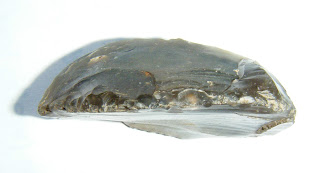 |
| The Late Roman Town House |
If you have run my little film you can see that Dorchester has the best example of a Roman town house in the UK. A town house is different to a villa in that not only is it in a town they are generally not the same ground plan.
During the construction of the new County Hall in 1937 the Dorset Natural History and Archaeological Society, led by Lt-Col. C.D. Drew and Mr K.C.Collingwood-Selby, excavated the site in advance of the building works. They found a series of structures of the 4th century, the earliest sequence being three separate houses of around 300 AD which were then converted into one house with outbuildings c.350 AD.
In the South Range of rooms there was a kitchen and store, a living room with a shrine (as most well-to-do houses had at this time) and a centrally heated bedroom, with a furnace against the outer west wall and the hypocaust taking air under the floor and up into the walls. With no windows this room would have been very cosy. This section of the house was fronted by a loggia or open corridor supported by columnettes, many of which were found at the bottom of the well, one being set up on site and the others taken to the county museum.
In the West Range of rooms was a small study off an entrance hall, a summer dining room, a corridor/living space and a bedroom. The only room to have a hypocaust was the winter dining room which turned into a summer bedroom.
Some of the best mosaics in Britain were found here, including the only known striped mosaic.
 |
| The blue & orange mosiac had a later circular intrusion |
In the summer dining room (or triclinium-3 couches) the mosaic would have been of Dionysius riding a leopard with the surviving sections of the four seasons (although the middle did not survive these mosaics were made to a pattern). 8,200 tesserae (small squares of fired clay) were used just for the red border. This mosaic was copied from a much earlier 2nd century example. In the winter dining room the mosaic has an interlacing design, the only one in the UK. Also in this room was found an inscription, Paternus scripsit, or 'Paternus wrote this'. It was written twice and thus could be a school pupil practicing, or just being naughty.
Into the 5th century and after Roman rule collapsed, the house was used more in the way of an early medaieval hall, with a fire in the centre of the largest room and one bedroom turned into a kitchen with storage bins for grain.
 |
| Some of the finds |
One unsettling discovery was that of several babies, which are now marked by plaques around the site. I remember finding such an infant burial in London, under a waterfront Roman warehouse next to London Bridge, some years ago. It is not as callous as at first sight. Babies were not human beings until they could recognise themselves (perhaps by name), which normally occurs around 2-3 years old. If they died naturally they are seen as pure spirits and it is lucky for the house and family to have them buried under the home. However, if the father did not recognise the infant as his they could be dumped onto the town refuse pile to die. All adults had to be buried outside of the town precincts.
Being situated at the back of the County Hall buildings this wonderful place is not visited as much as it should be. If you are in Dorchester do take some time to visit or better still come on one of my Dorchester walks.

























